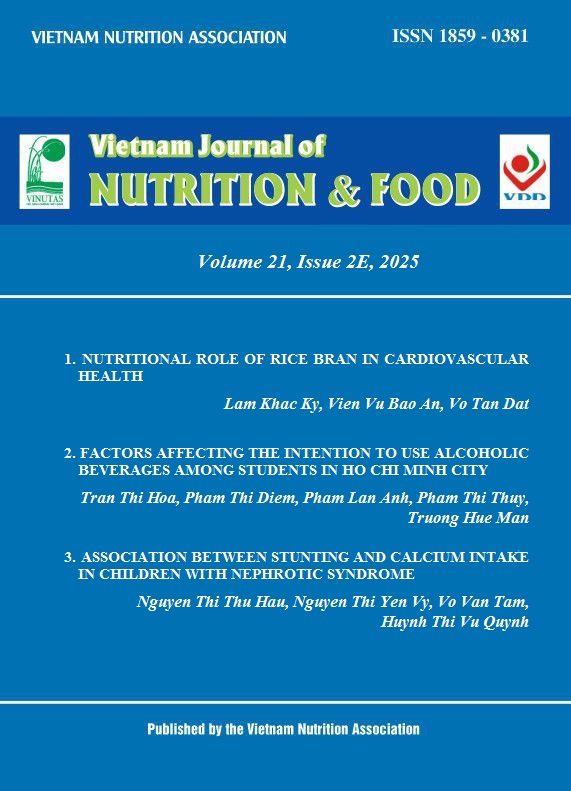SARCOPENIA AND ASSOCIATED FACTORS IN HEAD AND NECK CANCER PATIENTS UNDERGOING CHEMOTHERAPY
Nội dung chính của bài viết
Tóm tắt
Aims: This study aimed to explore the relationship between sarcopenia and clinical, biochemical factors in head and neck cancer (HNC) patients undergoing chemotherapy. Specifically, the study focused on the role of BMI in assessing sarcopenia risk in this patient population.
Methods: A cross-sectional study was conducted on 68 patients with HNC undergoing chemotherapy at a tertiary hospital. Inclusion criteria included confirmed diagnosis of HNC, active chemotherapy treatment, availability of clinical and biochemical data, and voluntary consent to participate. Data were collected on clinical factors (age, gender, BMI, ECOG status), Complete Blood Count and biochemical markers (lymphocytes, hemoglobin, albumin, potassium, sodium, chloride, creatinine, AST, ALT). Sarcopenia was assessed using the AWGS 2019 criteria. Logistic regression analysis was performed to identify associations between sarcopenia and clinical/biochemical variables.
Results: The mean age of participants was 58.12 ± 12.25 years, with males comprising 76.5% of the cohort. The average BMI was 21.13 ± 3.44 kg/m². Sarcopenia prevalence was 51.5% overall, with rates of 100% in patients with BMI < 18.5, 54.1% in those with BMI 18.5–23, and 5.9% in BMI ≥ 23. Logistic regression revealed a significant inverse association between BMI and sarcopenia (p = 0.005, OR = 0.60), indicating that lower BMI strongly predicts sarcopenia. Other factors such as age, gender, and albumin levels showed no significant association.
Conclusion: The study underscores that BMI, while unable to differentiate fat mass from lean mass, remains a practical and valuable tool for monitoring sarcopenia in HNC patients undergoing chemotherapy. Nutritional interventions to maintain an optimal BMI could mitigate sarcopenia risk, thereby improving treatment outcomes and overall prognosis in this vulnerable population.
Từ khóa
Sarcopenia, BMI, Head and Neck Cancer, Chemotherapy
Chi tiết bài viết
Tài liệu tham khảo
2. Martin L, Birdsell L, Macdonald N, et al. Cancer cachexia in the age of obesity: skeletal muscle depletion is a powerful prognostic factor, independent of body mass index. J Clin Oncol. 2013;31(12):1539-1547.
3. Prado CM, Purcell SA, and Laviano A. Nutrition interventions to treat low muscle mass in cancer. J Cachexia Sarcopenia Muscle, 2020;11(2):366-380.
4. Cruz-Jentoft AJ, Bahat G, Bauer J, et al. Sarcopenia: revised European consensus on definition and diagnosis. Age Ageing. 2019; 48(1):16-31.
5. Pham KH, Tran VL, Nguyen TL, et al. Describe the nutritional status of patients with head - face - neck cancer at Nghe An Cancer Hospital in 2020. Journal of Nursing Science. 2020;3(3): 28-32.
6. Van Tap N, Bang HT, Huong DT, et al. Malnutrition in hospitalized cancer patients: A single-center, cross-sectional study in Southern Vietnam. SAGE Open Med. 2023;11: 20503121231171491.
7. Chen LK, Woo J, Assantachai P, et al. Asian Working Group for Sarcopenia: 2019 Consensus Update on Sarcopenia Diagnosis and Treatment. J Am Med Dir Assoc. 2020; 21(3):300-307 e2.
8. Jovanovic N, Chinnery T, Mattonen SA, et al. Sarcopenia in head and neck cancer: A scoping review. PLoS One. 2022;17(11): e0278135.
9. Endo K, Ichinose M, Kobayashi E, et al. Head and Neck Cancer and Sarcopenia: An Integrative Clinical and Functional. Review. Cancers (Basel), 2024.16(20):3460. doi:10.3390/cancers16203460.
10. VanderVeen BN, Fix SK, and Carson JA, Disrupted Skeletal Muscle Mitochondrial Dynamics, Mitophagy, and Biogenesis during Cancer Cachexia: A Role for Inflammation. Oxid Med Cell Longev. 2017;2017: 3292087.
11. Gilliam LA and St Clair SK. Chemotherapy-induced weakness and fatigue in skeletal muscle: the role of oxidative stress. Antioxid Redox Signal. 2011;15(9): 2543-2563.
12. Fearon K, Strasser F, Anker SD, et al. Definition and classification of cancer cachexia: an international consensus. Lancet Oncol. 2011;12(5):489-495.
13. Baracos VE and Arribas L. Sarcopenic obesity: hidden muscle wasting and its impact for survival and complications of cancer therapy. Annals of Oncology. 2018;29: ii1-ii9.
Các bài báo tương tự
- Nguyễn Thị Thục Uyên, Nguyễn Thị Thu Hậu, TS. Đoàn Thị Ngọc Hân, BSCKII Hoàng Nguyên Lộc, BSCKI Nguyễn Mạnh Hưng, Phạm Thị Thúy Anh, TỶ LỆ SUY DINH DƯỠNG THẤP CÒI, TỐC ĐỘ TĂNG TRƯỞNG CHIỀU DÀI VÀ ĐẶC ĐIỂM NUÔI DƯỠNG Ở TRẺ 0 - 5 THÁNG TUỔI ĐẾN KHÁM TẠI PHÒNG KHÁM CHẤT LƯỢNG CAO BỆNH VIỆN NHI ĐỒNG 2 , Tạp chí Dinh dưỡng và Thực phẩm: Tập 20 Số 5 (2024)
Ông/Bà cũng có thể bắt đầu một tìm kiếm tương tự nâng cao cho bài báo này.


